An interesting film on the art of scrimshaw. Only 11 minutes long, it’s professionally shot featuring Brian Kiracofe from Newport, Rhode Island. He tells the history of scrimshaw as he works on a miniature piece of scrimshaw. He mentions his concern about the ivory ban well into it as well.
Author: Andrew Perkins
Identifying Ivory
I was set to create a long post about identifying ivory (there are many different types – just ask the tooth fairy) when I found this excellent pdf by CITES.org: http://www.cites.org/sites/default/files/eng/resources/pub/E-Ivory-guide.pdf.
The pdf is in black and white. Here are a couple of full color examples of pre-embargo elephant ivory, mammoth ivory and a “vegetable ivory” cross-cuts showing the Schreger lines in the ivories and the lack of them in the plant alternative (clicking on the image brings it up to full size):
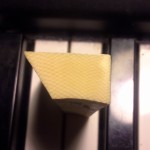
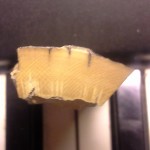
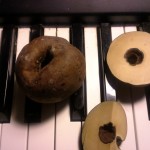

Scrimspirations – Illustrations to Scrimshaw and Other News
We’ve been busier at home than on the site throughout the winter which has finally left us. We’ve been busy creating illustrations, testing out alternative materials and doing too little scrimshawing.
Scrimspirations – Book 1 is a collection of photos with accompanying illustrations created especially for scrimshaw artists. Each photo comes with hand lined templates from 0.5″ up to 3.0″ so you can easily transfer the image to your material of choice.
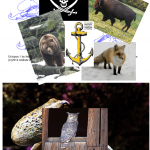
Some of the materials we’ve worked on include acrylic – an easy to use plastic that comes in many colors, “alternative ivory” – a molded polyester with a grain pattern, paper micarta, used most often as knife handles, casein – which is a plastic made from milk (we were able to get some from England where they stopped making it in the late ’70’s) and other materials. We’ll be showing our findings here over the next several weeks.
There are laws they are attempting to pass that could impact the use and sale of ivory which are alarming not only to scrimshaw artists, but musicians as well. In short, the previous laws passed to protect the whales was well thought out and measured. The laws they are currently debating, if passed, would make it very difficult if not impossible to re-enter the country with musical instruments which have ivory as their parts (such as guitars, violin bows, pianos, bagpipes and more) without being confiscated. read more here.
The New Bedford Whaling Museum will host the 26th annual Scrimshaw Weekend May 16-18. This internationally renowned event is the world’s only regular forum where collectors, dealers, curators, folk art and whaling history buffs share their interests in the indigenous art of whalers. see more at the New Bedford Whaling Museum.
Keep up on the posts by subscribing to our newsletter and get three patterns free! We’re working out the bugs on this right now, and hope to have it automated soon. Just look in the upper right-hand corner of the page.
Transferring an Image to Ivory – Graphite Paper
Graphite paper is similar to the old “carbon paper” they used to use back in the day. A few sheets can go a long way, especially if you are doing small jewelry cabochons.
- Simply cut out a piece and place it beneath the image you want to scribe, tape them both securely to the cab or other material.
- Using a mechanical pencil or ball point pen, trace over the images major lines firmly.
- Carefully remove the tape and the paper from the piece – the image should have appeared on your piece. Using this method you don’t have to print out a reverse image since it will transfer the way you see it on the paper, unlike placing your image face down and trying to transfer it chemically.
You can find graphite paper at most big box office supply stores or at Amazon.com
Below you’ll see two different types – one is a sampler with four different colors and one is plain black. I prefer the color since I can tell the difference easier if i do a scrim, fill repeat. The yellow also works on dark ivory or horn.
Clicking on the image will bring you to the product on Amazon.com
Scrimshaw Artist Elizabeth Dolbare
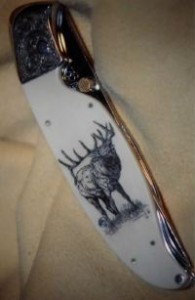 Elizabeth Dolbare is a scrimshaw artist and engraver from Wyoming. Taught by master engraver Guiseppe Forte and master engraver Sam Welsh who also scrimshawed, her work has been featured in popular gun and knife magazines. Her site can be seen at scrimshaw-engraving.com which is maintained by Mel Long who also maintains knifemaker.ws.
Elizabeth Dolbare is a scrimshaw artist and engraver from Wyoming. Taught by master engraver Guiseppe Forte and master engraver Sam Welsh who also scrimshawed, her work has been featured in popular gun and knife magazines. Her site can be seen at scrimshaw-engraving.com which is maintained by Mel Long who also maintains knifemaker.ws.
Elizabeth is also known for her tack engraving as well as motorcycle engraving!

